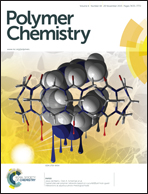Modular amphiphilic copolymer-grafted nanoparticles: “nanoparticle micelle” behavior enhances utility as dispersants†
Abstract
The majority of existing dispersant systems are based on small molecule amphiphiles and therefore are susceptible to disaggregation when sufficiently diluted. An alternative design is proposed using nanoparticles as a core to template amphiphilic polymers grafted onto their surface into a micelle-like conformation. Such amphiphilic “nanoparticle micelles” will not disaggregate upon dilution, similar to unimolecular micelles. These nanodispersants were prepared by grafting successive blocks of poly(ε-caprolactone) and poly(ethylene glycol) from functionalized silica nanoparticles through a combination of surface-initiated ring-opening polymerization and activated ester conjugation chemistry. The swellable hydrophobic poly(ε-caprolactone) inner block enabled the encapsulation of a hydrocarbon payload while the hydrophilic poly(ethylene glycol) outer block afforded stable dispersions in aqueous media. Their capacity for hydrocarbon encapsulation was confirmed by their ability to sequester ultraviolet active dyes in aqueous environments and because the length of the polymer blocks can be easily tuned, this design enables the optimization of their loading capacity. Additional characterization using light scattering-based methodologies combined with ultraviolet spectroscopy, 1H nuclear magnetic resonance, Fourier transform infrared spectroscopy, transmission electron microscopy, and thermogravimetric analysis experiments confirmed the nanodispersant structure and their “unimolecular micelle-like” behavior.


 Please wait while we load your content...
Please wait while we load your content...